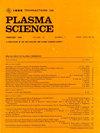大接触直径和间隙高电流真空电弧的数值研究
IF 1.3
4区 物理与天体物理
Q3 PHYSICS, FLUIDS & PLASMAS
引用次数: 0
摘要
当真空灭流器的电压等级增加到252kv (245kv)时,触点直径和间隙将显著增大。基于二维真空电弧(VA) MHD模型,研究了大接触直径(150mm)和间隙(70mm)的VA等离子体的特性。仿真得到了不同触点直径、触点间隙、阴极侧电流密度分布、断电流大小和轴向磁场(AMF)下弧柱等离子体参数的分布。仿真结果表明,在没有AMF的情况下,VA的收缩幅度很大。随着AMF的增大,颗粒温度和电流密度在阳极侧逐渐由中心聚集分布转变为环形分布。AMF对VA的控制作用减弱。减小断电流和接触间隙可以使轴向电流密度分布更加均匀,降低颗粒温度。接触直径的减小不利于大直径、大间距接触网的断裂。研究结果可以深入了解高压真空断路器的开关特性,为研制252kv真空断路器提供必要的理论依据。本文章由计算机程序翻译,如有差异,请以英文原文为准。
Numerical Study of Large Contact Diameter and Gap High Current Vacuum Arc
As the voltage level of the vacuum interrupter increases to 252 kV (245 kV), the contact diameter and gap will increase significantly. Based on the 2-D vacuum arc (VA) MHD model, this work explores the characteristics of large contact diameter (150 mm) and gap (70 mm) VA plasma. The simulation obtained the arc column plasma parameters distribution with different contact diameters, contact gap, cathode side current density distribution, breaking current size, and axial magnetic field (AMF). The simulation results show that the VA shrinks to a high degree when there is no AMF. As the AMF increases, the particle temperature and current density gradually change from a central agglomeration distribution to an annular distribution on the anode side. The control effect of the AMF on the VA weakens. Reducing the breaking current and the contact gap will make the axial current density distribution more uniform and the particle temperature lower. The reduction of the contact diameter is not conducive to breaking large diameter and large spacing VAs. The research results can provide an in-depth understanding of the switching characteristics of higher voltage vacuum circuit breakers and provide an essential theoretical basis for developing 252 kV vacuum circuit breakers.
求助全文
通过发布文献求助,成功后即可免费获取论文全文。
去求助
来源期刊

IEEE Transactions on Plasma Science
物理-物理:流体与等离子体
CiteScore
3.00
自引率
20.00%
发文量
538
审稿时长
3.8 months
期刊介绍:
The scope covers all aspects of the theory and application of plasma science. It includes the following areas: magnetohydrodynamics; thermionics and plasma diodes; basic plasma phenomena; gaseous electronics; microwave/plasma interaction; electron, ion, and plasma sources; space plasmas; intense electron and ion beams; laser-plasma interactions; plasma diagnostics; plasma chemistry and processing; solid-state plasmas; plasma heating; plasma for controlled fusion research; high energy density plasmas; industrial/commercial applications of plasma physics; plasma waves and instabilities; and high power microwave and submillimeter wave generation.
 求助内容:
求助内容: 应助结果提醒方式:
应助结果提醒方式:


